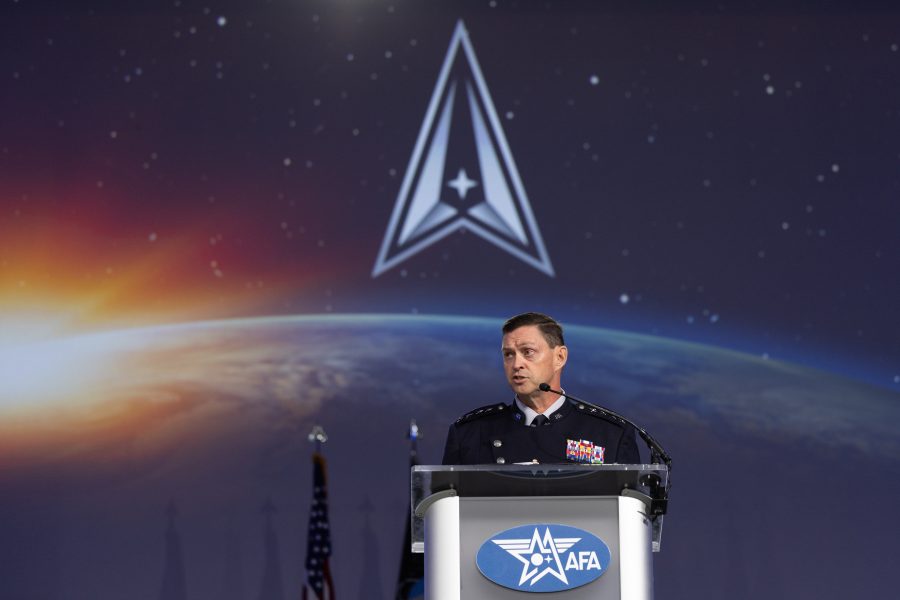As the Space Force prepares to mark its sixth birthday—and Gen. Chance Saltzman embarks on his last year as Chief of Space Operations—the service has released a new document meant to sum up its current status and all of Saltzman’s efforts to solidify the Space Force’s identity as a warfighting service.
In the opening lines of the “Space Force Vector,” released Nov. 14, Saltzman writes that the goal of the document is to help connect the dots between what the Space Force does and its mission to achieve space superiority.
“If every Guardian can internalize the concepts contained herein, I am confident that we will accelerate our transformation into a warfighting service; a Service that embodies warrior ethos, outpaces our adversaries, and protects our Joint Force and our Nation from space-enabled attack,” Saltzman wrote. “We must act quickly and with urgency, but the difference between haste and efficiency is understanding. Guardians must know why they do things before they can truly excel.”
Charles Galbreath, senior resident fellow at AFA’s Mitchell Institute for Aerospace Studies, said the “Vector” document provides a detailed look at the progress the service has made—as well as a look ahead at what Saltzman might still want to accomplish.
“It’s almost a way for Gen. Saltzman to say, ‘Here’s what I’m signing up to do over the next 12 months of my tenure—hold me accountable to it,’” Galbreath said.
Warfighting Identify
Under Saltzman, the Space Force has developed various doctrine, strategies, and concepts over the last few years foundational to how it plans, operates, and presents forces—Vector mostly serves as a broad overview connecting them all. That starts with the service’s “competitive endurance” theory, which the CSO unveiled in 2023. The concept identifies three core tenets for success: avoid operational surprise, deny first-mover advantage, and responsible counterspace campaigning.
It also makes several references to the Space Force’s transformation into a warfighting service—a shift Saltzman has made a particular focus of his tenure. The document argues that spacepower is so integral to joint operations that it has created a “strategic dependence.” And as space becomes more hostile, the Space Force has an imperative to “contest and control” the domain to maintain the missions that the military has come to depend on.
“Today, space is an increasingly contested warfighting domain, and thus, the Space Force must transform from a service provider into a highly skilled warfighting organization,” the document states.
The Vector walks through the functions that contribute to the service achieving those warfighting tenets: force design, force development, force generation, and force employment.
In the force design section, it highlights a forthcoming “objective force” document meant to lay out the Space Force’s vision for what platforms, support structures, and manpower USSF thinks it will need over the next 15 years. It also stresses the importance of science and technology investment and fielding “combat credible” forces.
On force employment, the Vector notes that a key part of presenting forces is normalizing spacepower so that it can be better integrated into the Joint Force. This normalization largely comes through the service’s component field commands, which are integrated with the combatant commands. When supporting a named operation, the service component commanders offer formations called a Space Mission Task Force comprised of a commander, a command-and-control element, and combat formations that perform space operations.
“The SMTF elevates and normalizes space operations by ensuring that the senior ranking Space Force commander in a Joint Force reports directly to the Joint Force commander and has all the combat capability and expertise to execute the mission,” the document states.
To-Do List
As for its forward-looking elements, the Vector lists several initiatives the service is pursuing in each areas. In the force design section, it points to priorities like operationalizing the Space Force’s Commercial Space Strategy, digitizing much of its acquisition and development processes, and improving the way it tests and validates new capabilities.
The document also highlights the service’s plans to integrate part-time Guardians no later than July 2026 and points to efforts to continue its transition into a “warfighting service,” by supporting capabilities like space domain awareness, space control, and Golden Dome; shifting to competency-based assignments; and increasing the launch tempo at its spaceports.
“Done right, our efforts will complete our transformation into a warfighting service, deliver combat-ready forces to the combatant commands, and field the capabilities we need to secure Space Superiority for the Joint Force and our nation in a rapidly evolving operating environment,” the document states. “We cannot predict the future of the Space Force, but we know the direction in which we must travel and the speed at which we must change.”


